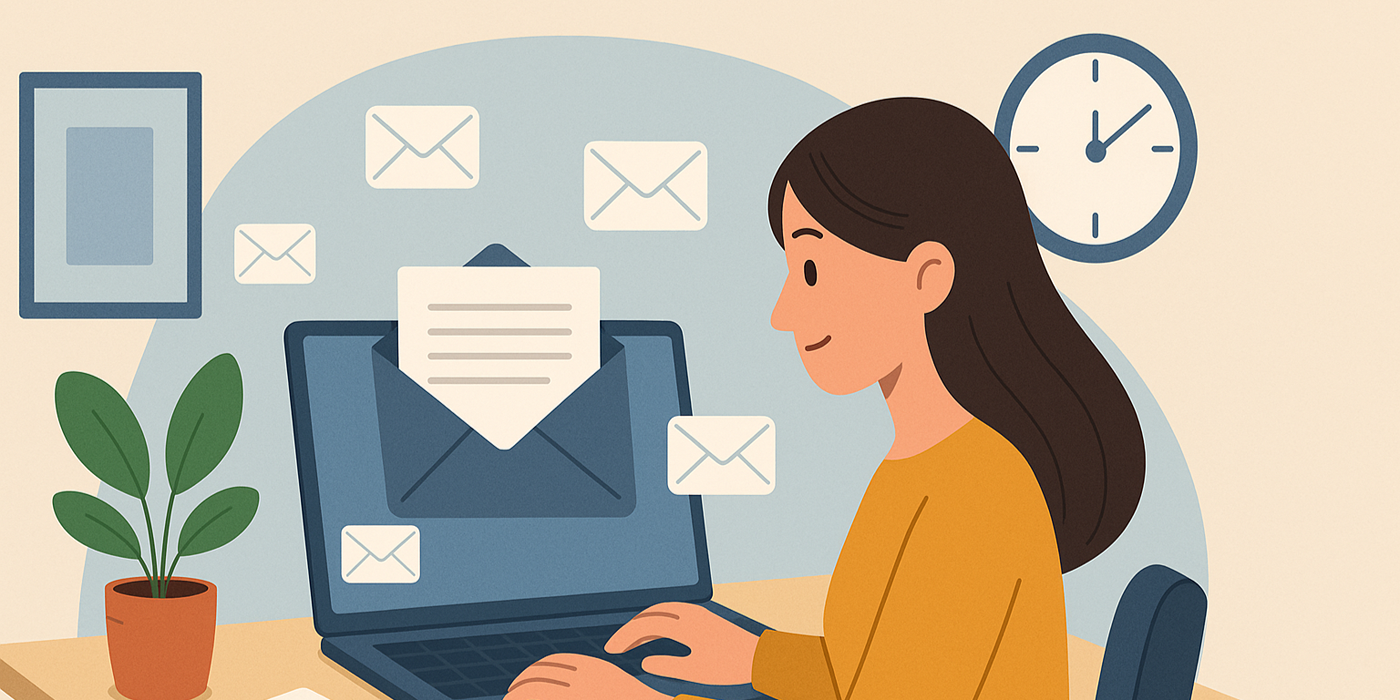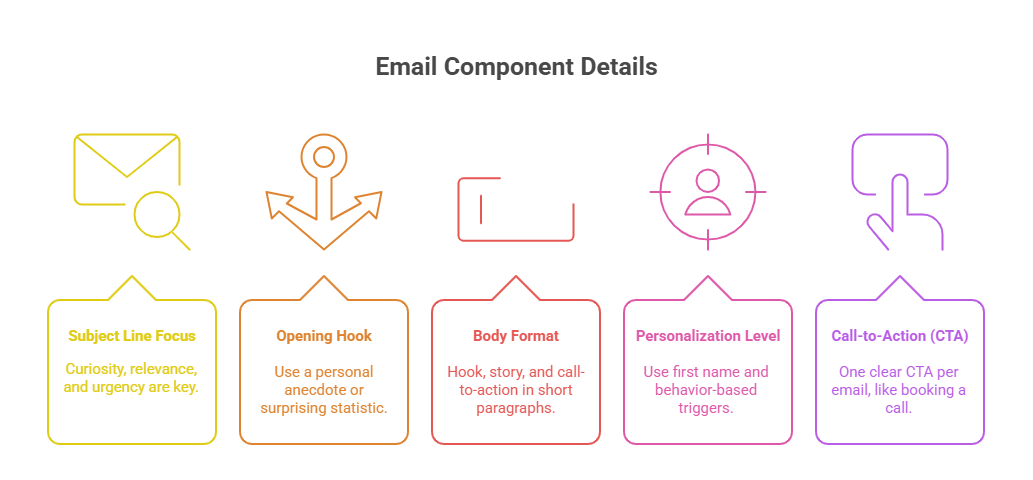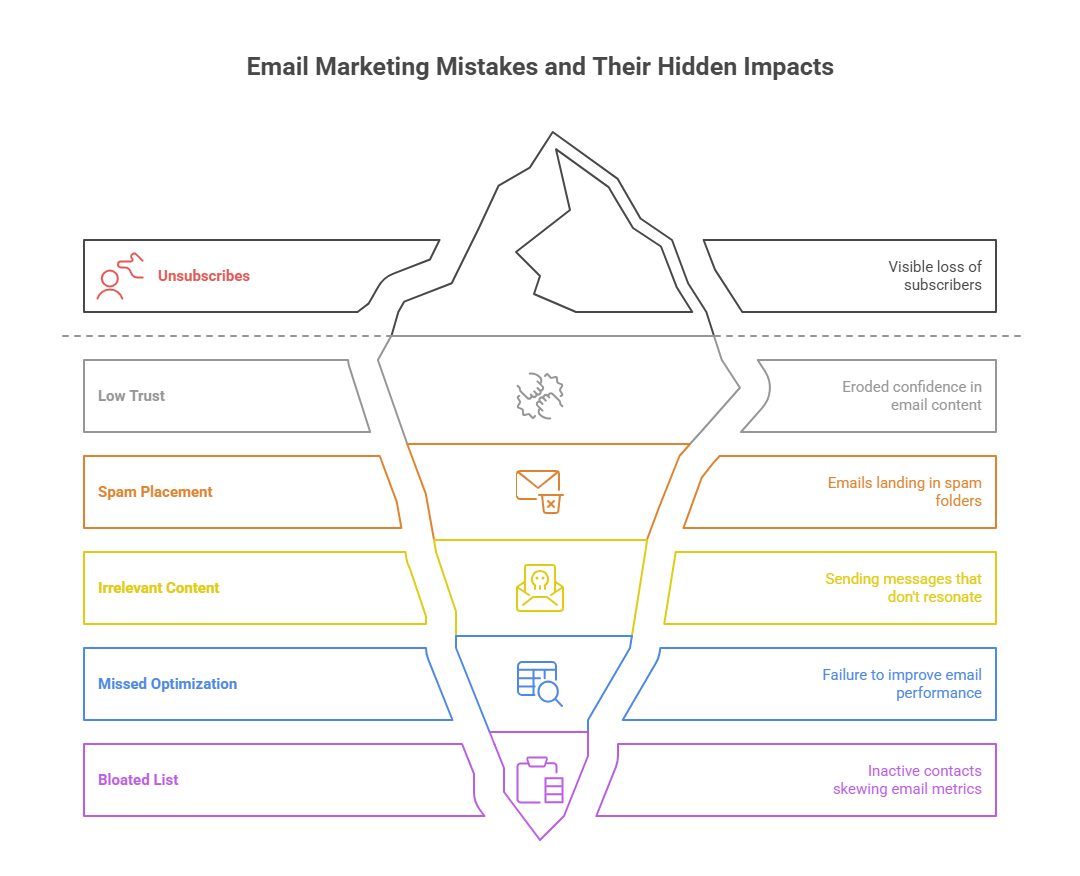Email Marketing Strategies for Coaches
If you're not building your email list, you're leaving money on the table. Unlike social media, email gives you full control over communication, direct access to your leads, and the ability to build lasting trust. For coaches, this isn't optional — it's your most reliable tool for conversions. With a $36 average ROI for every $1 spent, email marketing remains unmatched in profitability and precision.
Yet most coaches delay it, focusing on content or social growth while ignoring the one asset they truly own: their list. Whether you’re booking discovery calls, launching programs, or selling courses, your email list is your engine. In this guide, I’ll show you exactly how to build it from scratch, write emails that convert, automate with ease, and avoid fatal mistakes. No fluff, no wasted effort — just real, scalable email marketing strategy designed for coaches who want results.
Building a List From Day One
Lead Magnet Essentials
Your list starts with a reason for people to join it. That reason is your lead magnet. Coaches often underestimate how powerful a specific, results-driven freebie can be. Generic PDFs won’t cut it — your offer needs to solve a real pain point, fast. For example, a burnout coach might offer a “5-Minute Morning Reset Plan” while a relationship coach could share a “Breakup Recovery Blueprint.” These aren't just catchy titles — they promise transformation.
Make sure your lead magnet:
Solves one clear problem
Has an outcome within 5–10 minutes
Leads naturally into your paid offer
Don’t create a freebie in isolation — reverse-engineer it from your coaching offer. This ensures that everyone entering your list is a qualified lead. When your freebie is tightly connected to your service, conversions skyrocket.
Using Social & Website Popups
If you’re not using popups, you’re leaving leads on the table. Add exit-intent popups to your coaching website, scroll-triggered forms on blog posts, and embed opt-ins in high-traffic pages. On Instagram, don’t just link to your homepage — send people to your freebie via Linktree alternatives like Taplink or Beacons, with clean copy that emphasizes urgency.
Your bio, your stories, your pinned posts — they should all have a direct path to your email list. Social media is where people discover you, but your list is where they convert. Create one path, one goal, and remove all friction.
Welcome Sequence to Build Trust
Once someone opts in, your welcome sequence does the heavy lifting. A solid 3–5 email sequence introduces your coaching philosophy, positions your authority, and invites them to take the next step. The structure should look like:
Thank you + value delivery
Your story & what you do
A key transformation or client win
Common mistake myth-busting
Invitation to discovery call or free resource
Automate this once and optimize it quarterly. These first emails are where your audience forms their opinion of you. Don’t just inform — connect, relate, and lead them to the solution you offer.
Writing Emails That Convert
Subject Line Psychology
Your subject line is the gatekeeper. If they don’t open, your content doesn’t matter. For coaches, subject lines must do three things: spark curiosity, imply urgency, and connect emotionally. Avoid spammy tricks — instead, use clean, punchy lines like:
“This helped my client quit her 9–5”
“Are you making this mistake in your morning routine?”
“How to stay calm when everything feels off”
Use personalization tokens when possible: “[First Name], your reset plan is inside” consistently boosts open rates. Also, test emojis and punctuation sparingly. A/B testing subject lines weekly will teach you exactly what your audience responds to — and that insight is pure gold.
Content Structure (Hook > Story > CTA)
Every email should follow a structure: Hook > Story > CTA. The hook grabs attention, the story builds relevance, and the CTA drives action. For example:
Hook: “Yesterday, I almost quit coaching.”
Story: A brief, authentic moment your audience can relate to
CTA: “If you’ve ever felt the same, hit reply and let’s talk — I’ve got space for one clarity call this week.”
Your story doesn't need to be dramatic. It needs to reflect the reader’s inner voice, showing you understand their struggle. Only then will they take the next step — whether that’s reading a coaching blog, booking a call, or enrolling in your program.
Personalization & Segmentation
Sending the same email to your full list kills engagement. Instead, segment based on interest, behavior, or journey stage. Tag subscribers based on:
Which lead magnet they downloaded
Which emails they’ve clicked on
If they’ve booked a call or made a purchase
Use this data to send targeted messages. For example, someone who downloaded a stress-relief guide should receive follow-up emails around emotional regulation or burnout prevention — not sales emails for a productivity course.
Finally, personalize beyond the first name. Reference what they’ve opted into, use “you” language, and make your writing feel like a conversation — not a blast. The more personal it feels, the higher your conversions will climb.
Campaign Types That Drive Results
Nurture Campaigns
Nurture emails are how you build long-term trust without selling. These should educate, inspire, and reinforce your unique coaching voice. A solid nurture sequence includes:
Quick wins (e.g., “3-minute breathwork to reset your mind”)
Behind-the-scenes moments (e.g., “Why I canceled my first webinar”)
Client case studies (but told as stories, not testimonials)
FAQ-style insights (answering real concerns your audience has)
Send one nurture email per week. Keep it valuable, skimmable, and emotionally resonant. The goal isn’t to sell — it’s to stay top-of-mind, so when they’re ready, you’re the obvious choice.
Launch Sequences
Launch emails are high-conversion drivers — but only if done strategically. A typical sequence should look like:
Pre-launch: Build anticipation (“Something big is coming…”)
Open cart: Announce the offer
Benefits breakdown: Highlight results, not features
Social proof: Real people, real outcomes
Urgency emails: Cart closing soon, limited spots, bonus ending
Last call: Direct, clear CTA to buy or book
Each email should push one clear action, not a list of links. Also: launch to warm segments. Cold subscribers rarely convert — so nurture first, launch second.
Weekly Value Emails
Think of this as your “content heartbeat.” Weekly value emails should deliver consistent insight that reinforces your authority. Examples include:
“The 3 habits I give every overwhelmed client”
“Why mindset isn’t enough — and what to focus on instead”
“How I helped a client triple her coaching bookings in 30 days”
Don’t be afraid to reuse or expand on social media content — just format it cleanly for email. Include 1 CTA per email — even if it’s just “hit reply and tell me what you think.” Engagement leads to deliverability, and deliverability leads to revenue.
| Campaign Type | Purpose |
|---|---|
| Nurture Campaign | Builds trust through value-driven weekly emails |
| Launch Sequence | Drives urgency and conversions during a program or product release |
| Weekly Value Emails | Delivers consistent tips, insights, or stories to establish expertise |
| Client Milestone Flow | Celebrates coaching progress to reinforce momentum and commitment |
| Re-Engagement Emails | Pulls inactive subscribers back with fresh value or updated offers |
Automation Essentials for Coaches
Best Tools (ConvertKit, ActiveCampaign)
The right tool can make or break your email strategy. For coaches, simplicity, flexibility, and scalability are non-negotiable. Two standout platforms:
ConvertKit – Designed for creators, it’s beginner-friendly and offers powerful automation. Its visual builder, easy tagging, and high deliverability rates make it ideal for solo coaches or small teams.
ActiveCampaign – More robust, with deep CRM features and advanced workflows. Best suited for coaches running group programs, evergreen funnels, or multiple offers at scale.
Whichever platform you choose, make sure it allows:
Behavior-based tagging
Custom triggers
Easy integration with your landing pages and calendar tool
Visual automation mapping for clarity
Don’t get distracted by features you won’t use. Focus on what gets your message to the right person at the right time.
Trigger-Based Journeys
Email automation isn’t just about sending emails — it’s about sending the right email when your lead is most engaged. That means building trigger-based journeys that respond to user actions.
Set up workflows like:
Opt-in trigger → Welcome sequence
Link clicked in email → Tag and send next relevant piece
Discovery call booked → Pre-call email with expectations
Didn’t purchase post-webinar → Objection handling sequence
These automations help you close gaps in the journey, keeping prospects warm even if they don’t convert right away. Bonus: once set up, these systems run on autopilot, freeing up your time while increasing conversion rates.
| Automation Element | Function |
|---|---|
| Opt-in Trigger | Initiates welcome sequence immediately after lead magnet download or sign-up |
| Behavioral Tagging | Tracks user actions (clicks, views, downloads) to personalize follow-ups |
| Consultation Booking | Triggers pre-call reminders and post-call automation flows |
| Lead Scoring System | Assigns scores based on engagement to prioritize leads |
| CRM Integration | Syncs contact info and coaching stages for holistic lead management |
Common Mistakes to Avoid
Over-Selling
Too many coaches treat every email like a pitch — and that’s the fastest way to lose subscribers. If your audience feels like you’re only showing up to sell, trust erodes fast. Instead, follow the 80/20 rule: 80% value, 20% promotion.
When you do pitch, make it clear why your offer matters now. Tie it to a timely problem, a recent insight, or an emotional shift your reader is experiencing. Don’t just promote — connect, then convert.
Ignoring Deliverability Scores
You could write the perfect email — but if it hits spam, it’s dead. Deliverability is often ignored, yet it controls how many people even see your message. Key actions to protect your score:
Avoid spammy words (“free,” “guaranteed,” “act now”) in subject lines
Maintain consistent send frequency
Use custom domain authentication (SPF, DKIM) to prove you’re legit
Monitor open rates and bounce rates weekly
Healthy list hygiene is more important than list size. Always track deliverability metrics alongside clicks and replies.
Not Cleaning Lists Regularly
Coaches often hold onto inactive subscribers, thinking a bigger list equals more impact. It doesn’t. Inactives kill your deliverability and skew performance data.
Once a quarter, run a re-engagement campaign with a clear ask: “Still want to receive these?” If they don’t respond, remove or archive them. Clean lists mean:
Higher open and click rates
Better sender reputation
Emails reach inboxes, not junk folders
Your email list is a relationship, not a broadcast channel. Prune it like you would a client roster — quality beats quantity every time.
Templates & Funnels Aligned With the Health and Life Coaching Certification by ANHCO
Pre-Built Sequences for Coaches
If you’re certified through the Health and Life Coaching Certification by ANHCO, your email marketing should reflect the structured, transformational process you've been trained to deliver. That means using pre-built sequences that align with each phase of your client journey — from awareness to commitment.
We’ve created email funnels tailored for ANHCO-certified coaches, including:
Discovery call request flows
Habit-change onboarding sequences
Progress milestone check-ins
Program upsell + cross-sell emails
Re-engagement campaigns for dropped-off clients
These aren’t generic templates — they’re strategically mapped to the coaching frameworks taught in your certification, making it easier to reinforce behavior change while moving clients toward your premium offers.
Integration with Your CRM
You don’t need tech overwhelm. These email funnels integrate seamlessly with tools like ConvertKit, ActiveCampaign, and HubSpot — or even simple platforms like MailerLite. You’ll be able to:
Sync client tags from intake forms
Trigger automations post-consultation
Track engagement and adjust messaging based on behavior
Pull in coaching milestones directly into your email flows
Your certification laid the foundation for high-impact transformation. These funnels make sure your email strategy delivers that transformation at scale, without sacrificing personal touch or energy.
Frequently Asked Questions
-
The sweet spot for most health and life coaches is one email per week. This keeps your audience warm without overwhelming their inbox. Weekly emails allow you to deliver consistent value, reinforce your coaching philosophy, and stay top of mind. If you’re running a launch or a time-sensitive challenge, you can increase frequency temporarily — up to once per day during launch week. The key is to ensure every email has a purpose. Avoid ghosting your list for weeks, then spamming them with back-to-back promotions. Consistency breeds trust, which is essential for coaches selling transformation.
-
You don’t need a large following to grow an engaged email list. Start by creating a targeted lead magnet that solves a specific problem your ideal client faces — like a “7-Day Stress Reset” or a “Meal Plan for Busy Moms.” Promote it consistently on your website, in social bios, and in every piece of content you post. Use free tools like ConvertKit landing pages or Canva-designed PDFs to keep things simple. Ask friends, past clients, and followers to share it. When your freebie delivers value, word of mouth accelerates growth — even from a small base.
-
At minimum, every health or life coaching email funnel should include:
Welcome sequence (3–5 emails that introduce your mission and method)
Lead nurturing emails that deliver tips and quick wins
Launch sequence that clearly explains your offer, the transformation, and urgency
Follow-up emails for non-buyers with value, objection handling, and a secondary offer
You may also include milestone check-ins, re-engagement emails, and testimonial showcases. These funnels reflect your coaching journey, taking a cold lead to a committed client in a step-by-step progression.
-
Focus on coaching, not pitching. Emails that feel too promotional often fail to connect emotionally. Instead of leading with your offer, lead with a relatable insight or challenge, then introduce your offer as a solution. Use storytelling to demonstrate outcomes — “My client Lisa used this tool and finally got 7 hours of sleep a night.” Use the CTA sparingly and clearly, like “Want help implementing this? Here’s where to start.” The more your email feels like a personal note, the more likely people are to click and trust your process.
-
A newsletter is an ongoing content stream — usually sent weekly — that delivers value, tips, and updates. A funnel, on the other hand, is a pre-written, automated email journey triggered by an action (like signing up for a freebie or booking a call). Newsletters keep your audience engaged over time. Funnels move leads toward a specific goal — often conversion. Both are essential. Think of newsletters as nurturing and visibility tools, while funnels are conversion systems that run in the background, guiding subscribers step-by-step toward your coaching program.
-
Track these four core metrics:
Open Rate – Tells you how effective your subject lines and sender name are.
Click-Through Rate (CTR) – Measures how compelling your content and CTA are.
Conversion Rate – Tracks actions taken, like booking a call or purchasing a program.
Unsubscribe Rate – Helps identify if your content is aligned with your audience.
You can also monitor bounce rates and engagement over time to evaluate list health. Don’t obsess over open rates alone. A smaller, more engaged list will always outperform a large list with no clicks or conversions.
-
Absolutely. In fact, repurposing content from social posts into email is smart. Most of your audience doesn’t see everything you post on social, so email gives that content a second life — but with more intention. The key is to adjust the format for email, using better hooks, clearer flow, and a defined CTA. For example, a carousel about burnout signs can become a powerful email story that ends with a discovery call link. Repurposing also saves you time, helping you stay consistent without reinventing the wheel.
The Take Away
If you want consistent clients, you need consistent email marketing. As a coach, your inbox is more than a delivery tool — it’s your most powerful conversion channel. Unlike social platforms, email gives you direct, unfiltered access to people who’ve already raised their hand. But success doesn’t come from sending random updates. It comes from clear sequences, strategic automation, and value-driven content that meets your audience where they are.
Start simple: one lead magnet, one weekly email, and one welcome sequence. Build from there. Focus on solving real problems, segmenting your list, and testing what resonates. When done right, your email list becomes a predictable engine for discovery calls, program signups, and long-term loyalty.
| I'm already using email marketing regularly |
| I'm planning to start soon |
| I need help setting it up |




